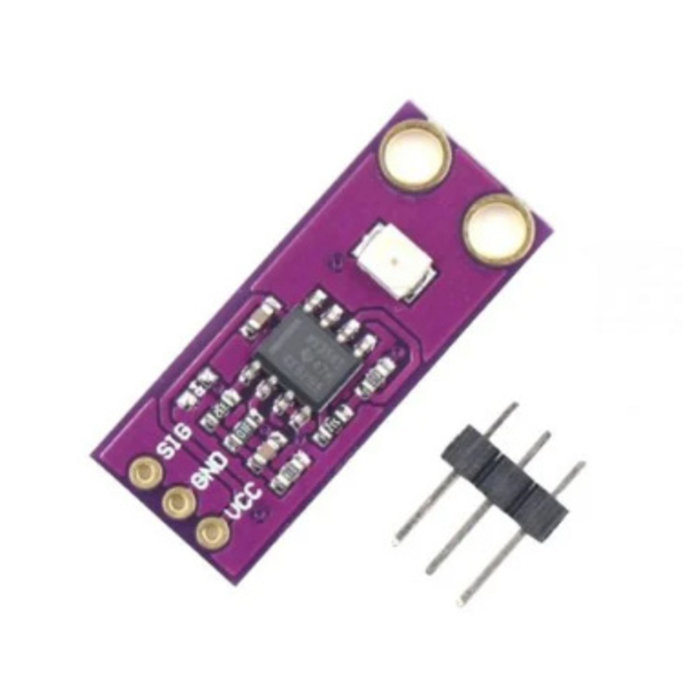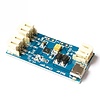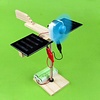
Ship to all EU countries
Art: NB071EAN: 8720618827371
GUVA-S12SD UV Sensor Module (OT3549)
Show all:
Sensors,Light Sensors
Would you like to order large quantities of this product or do you need a quote to order within your organization? Then request a quote.
REQUEST QUOTEThank you for your request.
You will receive the quote in your mailbox within a few minutes.
You will receive the quote in your mailbox within a few minutes.
Ship to all EU countries
Ordered on working days before 3:00 PM = shipped the same day.
30 days cooling-off period
1 jaar garantie
Description
Analog UV Light to Voltage Converter for Measuring UV Light IntensityThe GUVA-S12SD UV Sensor Module is used for detecting the intensity of ultraviolet radiation. This module has an analog output that changes with the intensity of UV light. PACKAGE INCLUDES:GUVA-S12SD UV Light Sensor Module3-pin male headerKEY FEATURES:Detects UV light in the range of 240nm – 370nmAnalog output voltage proportional to the UV index of UV light incident on the detector3.3 and 5V compatibleThe GUVA-S12SD is a true UV detector that only detects light from 240nm to 370nm, the UV-B and most of the UV-A spectrum. It also picks up the high end of UV-C.GUVA-S12SD Responsivity GraphThe UVC wavelengths are used in blacklights, tanning beds, reptile UV emitters, germicidal sterilizers and similar applications. This module can be used to monitor the operation of those devices. It can also be used to measure the UV Index, which provides a scale to determine how intense the UV sun is and therefore what protective measures should be taken.The UV Index scale is published by the EPA and is intended to give people advice about sun exposure and what protective measures they should take to minimize sun damage.SIG or SIO = Signal Output – Connect to MCU Analog InputGND = GroundVCC = 2.7V to 5.5V. Connect to Vcc of the MCU (usually 3.3 or 5V)Module AssemblyThe module comes with the male header strip detached. The header can be soldered to the top or bottom of the module depending on its intended use, or wires can be used to make the connections. For breadboard use, we place the headers on the bottom. Soldering is easiest if the header is inserted into a solderless breadboard to hold it in place during the soldering process. How the GUVA-S12SD UV Sensor Module Works The module contains an LM358 dual op-amp that converts the current output of the sensor to a voltage and then amplifies that output so that it can be read by the analog input on an MCU for taking UV measurements. The first stage op-amp outputs a voltage proportional to the sensor photocurrent of 4.3 * µA. If the photocurrent is 0.1 µA (0.09 mW/cm^2), then the output is 0.43V This feeds a second stage op-amp with an additional gain of 6.1x. In this example the final output is 0.43V x 6.1 = 2.62V.As configured the module is most useful for measuring moderate to moderately high UV light levels or if the sensor is placed behind a neutral density filter to reduce the percentage of UV falling on the sensor.If it is desired to measure very high UV levels the second amplification stage can be bypassed. This can be achieved by shorting the 5.1K resistor "512" and removing the 1K resistor to the right of it marked "01B" or "102". This changes the gain of the output amplifier to x1 effectively removing it from the circuit. With this change the UV index is then calculated by multiplying the output by 10.Please note as of 6/2021 we are modifying this module and it now ships with a 1M feedback resistor on the first stage as noted above. Before that date, the feedback resistor was 10M. 10M resistors are marked 01F, 1M resistors are marked 01E. With a 10M feedback resistor, the first stage is 43 * sensor photocurrent in µA. If the photocurrent is 0.1 µA (0.09 mW/cm^2), then the output is 4.3V.
Reviews
0/10
No reviews found
Add your reviewAlso interesting for you:
Kies je taal / Choose your language:
By using our website, you agree to the usage of cookies to help us make this website better.
Hide this messageMore on cookies »














